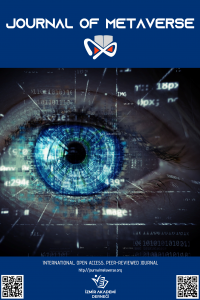Metaverse: Security and Privacy Concerns
Metaverse, privacy, security, virtual universe, buckets effect
Metaverse: Security and Privacy Concerns
Metaverse, privacy, security, virtual universe, buckets effect,
___
- N. Stephenson, Snow crash: A novel. Spectra, 2003.
- L.-H. Lee, T. Braud, P. Zhou, L. Wang, D. Xu, Z. Lin, A. Kumar, C.Bermejo, and P. Hui, “All one needs to know about metaverse: A complete survey on technological singularity, virtual ecosystem, and research agenda,” arXiv preprint arXiv:2110.05352, 2021.
- B. Falchuk, S. Loeb, and R. Neff, “The social metaverse: Battle for privacy,” IEEE Technol. Soc. Mag., vol. 37, no. 2, pp. 52–61, 2018.
- Z. Chen, H. Cao, Y. Deng, X. Gao, J. Piao, F. Xu, Y. Zhang, and Y. Li, “Learning from home: A mixed-methods analysis of live streaming based remote education experience in chinese colleges during the covid-19 pandemic,” in Conf. Hum. Fact. Comput. Syst. Proc., ser. CHI ’21, 2021.
- H. Liu, X. Yao, T. Yang, and H. Ning, “Cooperative privacy preservation for wearable devices in hybrid computing-based smart health,” IEEE Internet Things J., vol. 6, no. 2, pp. 1352–1362, 2019.
- J. Fox, M. Gilbert, and W. Y. Tang, “Player experiences in a massively multiplayer online game: A diary study of performance, motivation, and social interaction,” New Media Soc., vol. 20, no. 11, pp. 4056–4073, 2018.
- Q. Zhu, M. Chen, C.-W. Wong, and M. Wu, “Adaptive multi-trace carving for robust frequency tracking in forensic applications,” IEEE Trans. Inf. Forensic Secur., vol. 16, pp. 1174–1189, 2021.
- H. Wu, X. Tian, Y. Gong, X. Su, M. Li, and F. Xu, “DAPter: Preventing user data abuse in deep learning inference services,” in Proc. World Wide Web Conf., 2021, pp. 1017–1028.
- Y. Zhang, R. Zhao, X. Xiao, R. Lan, Z. Liu, and X. Zhang, “Hf-tpe: High-fidelity thumbnail- preserving encryption,” IEEE Trans. Circuits Syst. Video Technol., vol. 32, no. 3, pp. 947–961, 2022.
- N. Vishwamitra, H. Hu, F. Luo, and L. Cheng, “Towards understanding and detecting cyberbullying in real-world images,” in IEEE Int. Conf. Mach. Learn. Appl., 2021.
- M. Begum and M. S. Uddin, “Digital image watermarking techniques: A review,” Information, vol. 11, no. 2, p. 110, 2020.
- J. Li, J. Wu, J. Li, A. K. Bashir, M. J. Piran, and A. Anjum, “Blockchain-based trust edge knowledge inference of multi-robot systems for collab-orative tasks,” IEEE Commun. Mag., vol. 59, no. 7, pp. 94–100, 2021.
- S. Lee, M. Kim, J. Lee, R.-H. Hsu, and T. Q. S. Quek, “Is blockchain suitable for data freshness? an age-of-information perspective,” IEEE Netw., vol. 35, no. 2, pp. 96–103, 2021.
- Yayın Aralığı: Yılda 2 Sayı
- Başlangıç: 2021
- Yayıncı: İzmir Akademi Derneği
Virtual Reality Skateboard Extending Metaverse
Kanishka KATARİA, J CHANDANA, Athira RAGHUMADHAVAN, Komal GANDHİ, Kartik RAJA, Shilpa GİTE
Stelios IOANNIDIS, Alexios Patapios KONTIS
Architecting the Future: A Model for Enterprise Integration in the Metaverse
Amirmohammad NATEGHİ, Maedeh MOSHARRAF
Path To Gain Functional Transparency In Artificial Intelligence With Meaningful Explainability
Md. Tanzıb HOSAİN, Mehedi Hasan ANİK, Sadman RAFİ, Rana TABASSUM, Khaleque INSİA, Md. Mehrab SIDDIKY
Metaverse: Security and Privacy Concerns
Ruoyu ZHAO, Yushu ZHANG, Youwen ZHU, Rushi LAN, Zhongyun HUA
The Impact of Metaverse on Work Life: A Delphi Study
Muzaffer Can ATAK, Esma ERGÜNER ÖZKOÇ
A Bibliometric Analysis: Metaverse in Education Concept
Towards an Ethics for the Healthcare Metaverse
